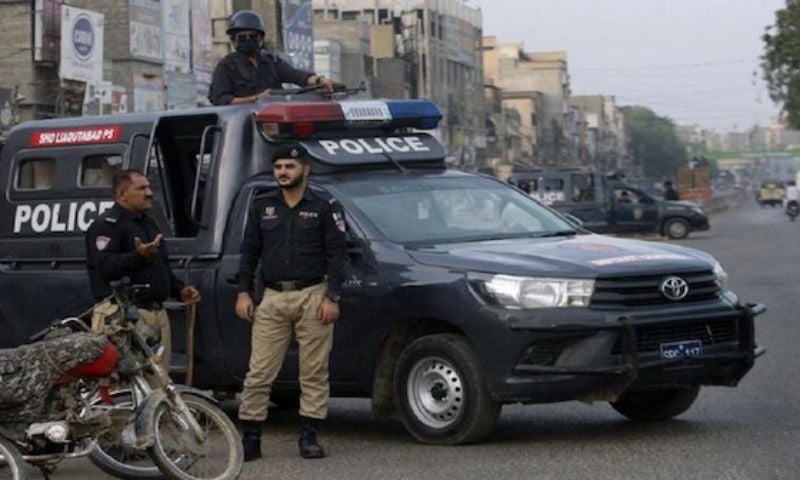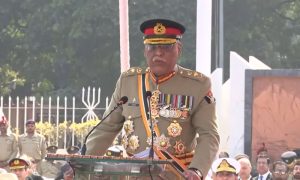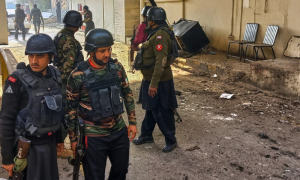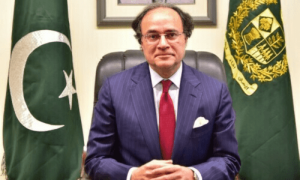KEY POINTS
- Violence surged: 1,961 policemen martyred between 2007–2025.
- Outdated rifles contrast militants’ US-made advanced weaponry.
- March 2025 witnessed 105 attacks, 335 lives lost.
- KP martyrs’ families receive compensation, plots, and education waivers.
- 2,160 families compensated, but delays still persist.
MARDAN, Pakistan: At Police Lines Mardan, the soft recitation of the Holy Quran and laying flowers with trembling hands marks the Police Martyrs Day on August 4 this year—not merely a ceremony, but a solemn reminder of the cost paid by Khyber Pakhtunkhwa’s bravest.
Among the mourners stands Hamida Bibi, a frail 90-year-old woman, clutching the photographs of her two martyred sons as if they were sacred relics. Her eyes—wet yet proud—carry decades of grief and resolve.
“I dreamed my sons would rise to high ranks,” she whispers. “One died after his marriage… the other just before his wedding. Two arrows have pierced my heart—but I hold my head high.”
Her elder son, Shad Muhammad, was survived by six young children—a family now woven into the larger tapestry of sacrifice that Khyber Pakhtunkhwa’s police have made in the fight against terrorism.
Rising toll of violence
Since the 1970s, 2,330 police personnel have paid the ultimate price in the line of duty across Khyber Pakhtunkhwa. But the scale of violence has risen sharply in recent years.
Two arrows have pierced my heart—but I hold my head high.” – Hamida Bibi
Between 2007 and August 2025, as many as 1,961 policemen were martyred—427 of them fell in between 2023 and mid-2025 alone.
Many came from the lower ranks, confronting daily threats with little more than aging AK-47 assault rifles and body armour long past its prime.
For constables stationed at remote check-posts, the risks are constant; a single patrol can mean walking into an ambush, while their families wait anxiously for news each evening.
Outgunned on frontlines
In stark contrast, militant groups are armed with US-made M16s, M4s, M24 sniper rifles, and thermal night vision gear—seized during operations and believed to have flooded into Pakistan after the US withdrawal from Afghanistan.
Though Kabul denies official involvement, Pakistani officials suspect a thriving black-market arms pipeline.
“We’re fighting a war with outdated tools,” says Peshawar-based journalist Haq Nawaz Khan, who has tracked militancy in the region for years. “The courage is there, but the weapons gap keeps widening.”
Mardan District Police Officer Zahoor Babar Afridi acknowledges the uphill battle, telling WE News English, “We’ve done a lot on training, restructuring, and public engagement. But we urgently need modern equipment to keep pace with evolving threats—and we are working on it.”
Bloodiest month since 2014
Across Pakistan, police in Khyber Pakhtunkhwa and Balochistan remain on the frontlines of the militant threat. Between February and June 2025, the country saw an alarming rise in violence.
We’re fighting a war with outdated tools. The courage is there, but the weapons gap keeps widening.”- Haq Nawaz Khan, journalist
March alone witnessed 105 attacks, leaving 335 dead—the bloodiest month since 2014.
Security analysts warn that this resurgence is not limited to border districts but is increasingly spilling into settled areas, where police stations and even urban patrols have become prime targets.
Pakistan Institute for Conflict and Security Study Q2 report shows a 32 per cent drop in terrorism incidents, but it admits that the Tehrik-e-Taliban Pakistan still calls the shot in Khyber Pakhtunkhwa.
Meanwhile, separatist outfits such as the Baloch Liberation Army and Baloch Liberation Front continue to mount attacks in Balochistan, stretching the country’s already strained security apparatus.
Experts argue that without comprehensive reform in policing and better coordination among intelligence agencies, such gains remain on shaky ground.
Compensation and care
In response to the growing toll, the Khyber Pakhtunkhwa government has revised its compensation and welfare policies.
Families of martyred constables now receive ₨11 million, while the families of IGPs are granted Rs23 million. Residential plots, ranging from five to 20 marlas depending on rank, have also been allotted.
Children of martyrs are entitled to educational waivers at institutions such as Abdul Wali Khan University in Mardan.
Risk allowances for lower ranks have been raised to Rs11,400 per month, and special desks for martyrs’ families have been established in every district to facilitate access to education, healthcare, and pensions.
We’ve done a lot on training, restructuring, and public engagement. But we urgently need modern equipment to keep pace with evolving threats—and we are working on it.” – Zahoor Babar Afridi, Mardan DPO
A Khyber Pakhtunkhwa police report states that of the 2,202 terrorism-related martyrdom cases, 2,160 families have been compensated, with the remaining cases delayed due to administrative hurdles.
Still, many families complain of bureaucratic red tape and long waits before receiving benefits. Some widows have taken up small jobs or rely on extended family support to bridge the gap.
“We’ve tried to support every family like our own,” the Mardan DPO claims. “Behind every number is a story—and we won’t forget them.”
Sacrifice lives on
Yet it is families like Hamida Bibi’s that give these numbers a heartbeat. Her resilience in the face of unimaginable loss reflects the spirit of thousands across the province.
As the ceremony concludes, she slowly rises, supported by relatives, her voice barely audible but firm.
“I may be alone now, but my sons live on—not just in these photographs, but in the soul of this soil.”

























